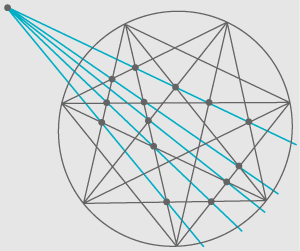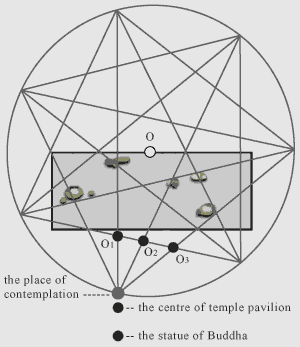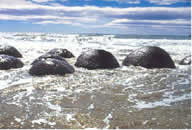According to geometrical concepts of a Japanese garden of stones it is supposed that the observer is in any point of contemplation in apex of a heptagon and perceives stones as objects which designate harmonious proportions of a geometrical figure, namely the observer is in one of points of a heptagonal network of lines and perceives proportional ratio of other points where lines of a heptagon are crossed. If the observer leaves from a point of contemplation then harmonious proportions have smaller influence. It is possible to tell that outside of points of contemplation the observer perceives the displaced picture of a stones garden as though sees a deformed geometrical figure, but nevertheless outside of points of contemplation and outside of a geometrical network of lines it is possible to find points where harmonious proportions of a stones garden are projected, that is shown on the chart:
 |
Blue color shows lines which pass through points where
lines of a heptagonal network are crossed. These blue lines incorporate
outside a heptagonal network in a uniform point where the perception of
harmonious proportions of a heptagon is possible, as well as in points
of contemplation within the framework of a heptagon. Provided that only
partial perception of harmonious proportions probably as blue lines pass
only on some points of crossings of lines in a heptagonal network. The shown blue lines it is possible to name "sublines", and also it is possible to use the term "subpoints of contemplation" for definition of points where sublines incorporate. |
At planning a Japanese garden of stones it is possible to take into account
subpoints of contemplation and to correlate subpoints to objects of
environmental space, or to have in subpoints any objects. And also it is
possible to coordinate subpoints of contemplation with an arrangement of stones,
namely it is possible to have stones of a Japanese garden in points of a
heptagonal network where sublines pass.
In total according to geometrical concepts of a Japanese garden of stones the
observer can be in the valid points of contemplation within the framework of a
heptagonal network of lines, namely in apexes of a heptagon, or the observer can
be in subpoints of contemplation outside a heptagon. But also the observer can
be directly in points where lines of a heptagonal network are crossed. It is
possible to tell that the observer can be in external locuses of a heptagonal
network, which correspond to apexes of a heptagon, or can be in subpoints of
contemplation, and also can be directly in internal locuses of a heptagonal
network where stones settle down. For example, in the garden of stones of the
Japanese temple Ryoanji there are three points which are internal locuses of a
heptagonal network and are on the verandah in the temple where observers can be
situated, that is shown on the chart:
 |
As it is possible to see, points O1 O2 O3 are internal locuses
of a heptagonal network within the framework of which the garden of
stones of the Japanese temple Ryoanji is located. These points are on
the verandah of the temple Ryoanji, and in essence if observers are in
these points then are in internal locuses of a heptagonal network that
allows to perceive harmonious proportions of a heptagon and proportions
of this stones garden with the greatest intensity. If observers leave
from these points then intensity of perception is reduced. Namely if the person appears in one of these points then perceives harmonious proportions of the stones garden more strongly, rather than people which are a beside on the verandah of the temple Ryoanji but which have no exact location in internal locuses of a heptagonal network of lines. |
Besides the chart has the marked point O in the centre of a heptagon. This
point is very significant as is in the centre of a geometrical figure where
forces and energy of environmental objects concentrate, and in particular forces
which exist in stones of a Japanese garden and in lines of a heptagon, and also
in any other objects on which lines and sublines of a heptagon are projected.
In essence the point O is a place in which there are metaphysical phenomena
similar to the phenomena which exist in the bases of the Egyptian pyramids or in
the bases of constructions which have forms of the Egyptian pyramids. As
pyramids too are geometrical figures in which harmonious proportions are made,
as well as in lines of a heptagon which is a basis of a Japanese garden of
stones.
If the person is in a point O and in the centre of a heptagon then he is the
subject who generates energy, and if the person is in any external point of
contemplation in any apex of a heptagon then he is the subject who perceives
energy. These are different processes as a result of which the person himself
generates and gives energy, or perceives and accumulates outside energy.
The Japanese garden of stones in the temple Ryoanji has no designated centre of
a heptagon and consequently observers can not feel processes which exist in the
centre, but on the verandah and in pavilion of the temple it is possible to
perceive and accumulate energy which concentrate in the centre.
If to construct a garden of stones where the observer can be in the centre of a
heptagon then it is possible to feel concentration of energy, and also the
person can generate energy in the centre of a heptagon. It is possible to assume
that in the ancient world there were such gardens of stones in which round
stones or stone spheres had arrangements according to lines of geometrical
figures. For example, researchers have found in jungle of Costa Rica the big
round stones having forms of spheres which have arrangements where it is
possible to see geometrical laws. And also in other places of our planet
researchers find similar round stone spheres which could be objects of ancient
megalithic constructions created according to laws of geometry. In particular
congestions of round stone spheres are on one of islands in archipelago of Franz
Josef land and in Kazakhstan, and also available in China and New Zealand, that
is shown in photos.



It is considered that the stone spheres shown in photos were formed as a result of volcanic processes, or are fossilized (petrified) sea mollusks or fossilized plants, namely are not man-made objects. But if to consider that stone spheres have a not casual arrangement in Costa Rica then it is possible to assume that founders of ancient megalithic constructions chose round stones and transferred to places where had round stones according to lines of geometrical figures. Namely it is possible to assume that round stone spheres were considered magic and consequently were applied to creation of megalithic constructions which basis could be lines of a heptagonal geometrical network or lines of other polygons.
Nine pages have shown the concept of a traditional Japanese garden of
stones and a perfect garden of stones, and also the concept of a megalithic
garden of mobile stones, which do not exhaust all probable nuances according to
which stones can be located, but main principles are listed.
More detailed information on "geometrical philosophy" of stone constructions and
about geometrical networks of lines of various polygons, within the framework of
which stones can be located, I shall try to publish in the future.